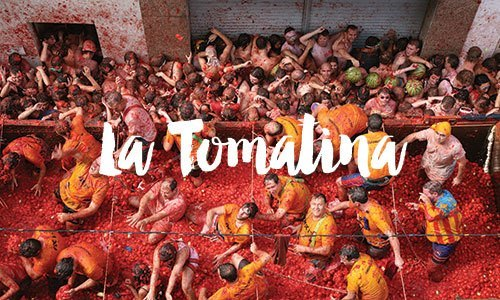La Tomatina is an annual food fight festival held in Buñol, a small town near Valencia, Spain.
Held on the last Wednesday of August, thousands of participants from around the world gather to throw ripe tomatoes at each other in a massive, joyful tomato battle.
Where & When
- Location: Buñol, Valencia, Spain
- Date: Last Wednesday of August (every year)
- Time: Typically starts at 11:00 AM and lasts about 1 hour
Historical Background
How Did La Tomatina Start?
The origins are somewhat unclear but most popular theories include:
- The Youth Fight Theory (1945)
- In 1945, during a local parade, young people wanted to join in but accidentally caused a participant to fall.
- An argument ensued, leading them to grab tomatoes from a nearby market stall and start throwing them.
- The following year, they returned with their own tomatoes — and a tradition was born.
- Accidental Tradition
- Some say it began with a food fight among friends that grew larger and repeated over time.
- Mock Protest Theory
- Others believe it started as a mock protest against town authorities — with tomatoes being used symbolically.
Ban and Official Recognition
- 1950s: Authorities banned the event due to public disorder concerns.
- Locals continued the tradition anyway.
- After persistent demand, the festival was officially sanctioned in 1957, celebrated with the “Tomatina Burial of the Sardine”, a mock funeral parade.
- 1980s Onward:
The Buñol Town Council officially took over organizing the festival, providing security and regulating the event.
How La Tomatina is Celebrated
The Pre-Fight Activities
- Palo Jabón (Greasy Pole):
A tall pole greased with soap is placed in the square, with a ham tied at the top.
Participants try to climb and claim the ham.
The tomato fight officially begins only after someone succeeds (though it often starts before anyone can reach it).
The Tomato Fight
- Trucks dump over 100 metric tons of ripe tomatoes onto the streets.
- At 11:00 AM, a cannon shot signals the start.
- Participants engage in a friendly, chaotic tomato fight.
Rules of La Tomatina
- Squash the tomato before throwing to avoid injuries.
- No hard objects — only tomatoes.
- No tearing clothes or aggressive behavior.
- Follow safety instructions.
- Stop when the second cannon blast signals the end.
After the Fight
- Fire trucks hose down streets.
- Locals and volunteers help clean.
- Participants often wash off in nearby rivers or public showers set up by the town.
- The streets of Buñol are cleaned surprisingly quickly, and the acidity in tomatoes helps disinfect the ground.
Cultural and Social Significance
- Symbol of Fun and Community:
La Tomatina is more about joy, fun, and community bonding than tradition or religion. - Tourist Attraction:
Attracts 20,000–40,000 participants yearly, boosting local tourism and economy. - Global Recognition:
Declared a Festivity of International Tourist Interest by the Spanish government in 2002.
La Tomatina Facts
- Originally free for all, now requires paid ticket due to crowd control and safety.
- Tomatoes used are specially grown, cheap, and overripe — inedible for sale.
- The festival is friendly, with strict safety measures in place.
- People from over 60 countries attend each year.

Similar Festivals Inspired by La Tomatina
- Colombia, Costa Rica, Chile, and Nevada (USA) hold their versions of tomato-throwing events.
But Buñol’s La Tomatina remains the original and most famous.
Controversies and Criticisms
- Food Waste Concerns:
Critics question using edible food for entertainment.
Organizers respond that the tomatoes are overripe and unfit for consumption. - Overcrowding:
The festival’s growing popularity forced organizers to introduce entry limits and paid tickets. - Environmental Impact:
Authorities take steps for water conservation and responsible cleanup.
La Tomatina is a unique, joyous, and messy celebration of fun, freedom, and community spirit.
From a local street brawl to an international festival, it remains a symbol of how spontaneity and shared laughter can become a beloved tradition. It’s not about the tomatoes — it’s about the experience, camaraderie, and once-in-a-lifetime adventure.
